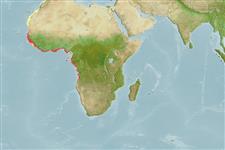Teleostei (teleosts) >
Eupercaria/misc (Various families in series Eupercaria) >
Haemulidae (Grunts) > Haemulinae
Etymology: Brachydeuterus: Greek, brachys, eia = short + Greek, deuter = two (Ref. 45335).
More on author: Valenciennes.
Environment: milieu / climate zone / depth range / distribution range
Ecology
Marine; brackish; benthopelagic; depth range 10 - 100 m (Ref. 57395), usually 15 - 80 m (Ref. 26999). Tropical; 35°N - 16°S, 19°W - 14°E (Ref. 54289)
Eastern Atlantic: west coast of Africa, from Mauritania to Angola (Ref. 57395). Also reported from Morocco (Ref. 2135).
Length at first maturity / Size / Weight / Age
Maturity: Lm 14.8 range ? - ? cm
Max length : 30.0 cm TL male/unsexed; (Ref. 57395); common length : 23.0 cm TL male/unsexed; (Ref. 3660); max. reported age: 7 years (Ref. 1113)
Dorsal spines (total): 10 - 13; Dorsal soft rays (total): 11 - 14; Anal spines: 3; Anal soft rays: 9 - 10. Diagnosis: body oblong and compressed; dorsal profile slightly and regularly convex; snout shorter than eye diameter (Ref. 57395). Mouth large, oblique (Ref. 5377, 57395) and protrusible (Ref. 57395). Lower jaw slightly prominent; 2 anterior pores on chin, followed by a median pit bearing openings of two large pores (Ref. 57395). Eyes large (Ref. 5377). Dorsal fin deeply notched; caudal fin deeply forked; scales ctenoid on body and head (Ref. 57395).
Coloration: back olivaceous, sides silvery to white; dark spot at angle of opercle; sometimes several small, dark spots on dorsal-fin base (Ref. 57395). Fins grey (Ref. 5377).
Inhabits coastal waters (Ref. 2683). Semipelagic, remains near the bottom during the day and moves up to the open water at night (Ref. 5377, 57395). Occasionally enters lagoons and estuaries at start of sexual maturation (Ref. 57395). Occurs over sandy and muddy bottoms. Feeds on invertebrates and small fishes (Ref. 5535).
Life cycle and mating behavior
Maturity | Reproduction | Spawning | Eggs | Fecundity | Larvae
Distinct pairing during breeding (Ref. 205).
Roux, C., 1990. Haemulidae. p. 783-788. In J.C. Quero, J.C. Hureau, C. Karrer, A. Post and L. Saldanha (eds.) Check-list of the fishes of the eastern tropical Atlantic (CLOFETA). JNICT, Lisbon; SEI, Paris; and UNESCO, Paris. Vol. 2. (Ref. 6946)
IUCN Red List Status (Ref. 130435: Version 2024-1)
Threat to humans
Harmless
Human uses
Fisheries: highly commercial
Tools
Special reports
Download XML
Internet sources
Estimates based on models
Preferred temperature (Ref.
123201): 17.3 - 27.9, mean 21.5 °C (based on 210 cells).
Phylogenetic diversity index (Ref.
82804): PD
50 = 1.0000 [Uniqueness, from 0.5 = low to 2.0 = high].
Bayesian length-weight: a=0.01259 (0.00791 - 0.02004), b=3.04 (2.91 - 3.17), in cm total length, based on LWR estimates for this species & (Sub)family-body (Ref.
93245).
Trophic level (Ref.
69278): 3.0 ±0.44 se; based on food items.
Resilience (Ref.
120179): Medium, minimum population doubling time 1.4 - 4.4 years (K=0.29-0.4; tmax=7;).
Prior r = 0.54, 95% CL = 0.36 - 0.81, Based on 1 full stock assessment.
Fishing Vulnerability (Ref.
59153): Low vulnerability (20 of 100).
Climate Vulnerability (Ref.
125649): Moderate to high vulnerability (48 of 100).
Nutrients (Ref.
124155): Calcium = 110 [23, 221] mg/100g; Iron = 0.883 [0.455, 1.714] mg/100g; Protein = 17.8 [16.0, 19.7] %; Omega3 = 0.244 [0.109, 0.450] g/100g; Selenium = 56 [30, 105] μg/100g; VitaminA = 33.3 [14.9, 71.8] μg/100g; Zinc = 1.75 [1.20, 2.52] mg/100g (wet weight);
